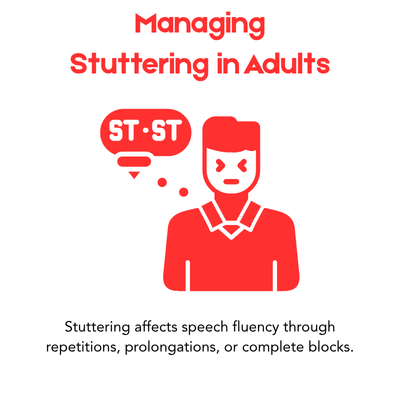
Adult communication challenges affect millions every day, including dysarthria. Stroke survivors struggle to find words and often use mouth exercises. Adults with cerebral palsy face speech clarity issues. Professionals seek accent modification to advance careers using a pacing board. Targeted adult speech therapy techniques can transform these challenges into success stories.
This guide covers methods that speech-language pathologists use to help adults with dysarthria improve speech, language, and voice using adult speech therapy plans. Techniques include swallowing therapy and vocal cord movement drills guided by a pacing board. These methods require professional guidance.
Building Clear Speech Through Articulation

Clear speech starts with precise muscle movements that adult speech therapy and language rehabilitation focus on, especially for clients with dysarthria or voice disorders navigating fluency disorders or other language disorders. Adults seeking pronunciation clarity often benefit from structured articulation exercises using a pacing board to guide pitch regulation and target specific sounds or speech patterns.
Strengthening the Foundation
Strong speech muscles create clearer sounds. Tongue strengthening exercises help adults develop the muscle memory needed for accurate sound production. A therapist might have you push your tongue against a tongue depressor or perform specific lip exercises to build strength and coordination.
Visual Learning with Mirror Exercises
Seeing your speech movements helps correct errors quickly. Mirror exercises let you watch tongue and lip positions while practicing difficult sounds. This visual feedback proves especially helpful for adults working on the “R” or “S” sounds that commonly cause trouble.
Building Speed and Precision
Once individual sounds improve, tongue twisters challenge your articulatory system. Phrases like “red leather, yellow leather” push you to maintain clarity while speaking faster. These drills build the motor precision needed for natural conversation.
Mastering Rhythm and Stress
Accent modification therapy focuses on intonation patterns and word stress. By practicing which syllables to emphasize in English sentences, adults can sound more natural while keeping their unique speaking style.
Research shows that systematic articulation therapy not only improves speech sound production but also builds confidence in social and professional settings. Each therapy plan targets individual needs through careful progress monitoring.
Rebuilding Language After Brain Injury

Language disorders like aphasia affect word-finding and sentence building abilities in adult speech therapy and impact those seeking accent modification.
Adults with these language disorders benefit from specialized language rehabilitation and adult speech therapy that rebuilds communication pathways in the brain.
Finding Lost Words
Word retrieval skills often suffer after stroke or brain injury. Therapists use semantic cues (meaning hints) and phonemic cues (starting sounds) to help you access vocabulary. If you can’t say “apple,” your therapist might say “It’s a red or green fruit” or provide the sound “ap-” to trigger the word.
Rebuilding Sentences
Many adults with aphasia struggle with sentence formation. Therapy involves expanding short phrases into complete thoughts. Picture description tasks help you practice including important details like who, what, and where while using proper grammar.
Real-World Communication
Conversation practice prepares you for daily interactions. Role-playing activities like ordering coffee or making phone calls help you use language spontaneously. You’ll learn communication strategies such as describing objects when specific words won’t come (“the thing you write with” for “pen”).
Supporting Family Success
Language intervention activities work best when families get involved. Therapists train loved ones to give you time to respond and use supportive communication techniques. This carryover support helps improvements transfer from clinic to home.
Adults with aphasia can continue improving their language abilities months or years after injury with consistent therapy. The key lies in personalized treatment that addresses your specific goals and communication needs.
Treating Motor Speech Challenges
Motor speech disorders happen when brain signals to speech muscles get disrupted. Two common conditions are apraxia of speech (motor planning problems) and dysarthria (muscle weakness or poor coordination).
Rebuilding Speech Patterns
Adults with apraxia of speech need intensive practice to build new motor pathways. Therapy focuses on phrase repetitions and word repetition exercises. You might start with simple words like “mom” and progress to complex sentences as your motor planning improves.
Strengthening Weak Muscles
Dysarthria often requires mouth exercises to improve muscle strength and coordination. These might include tongue movements, lip stretching, or blowing activities. Stronger speech muscles lead to clearer articulation and better voice control.
Controlling Speed and Timing
A pacing board helps regulate your speech rate by providing slots for each word or syllable. This tool teaches self-pacing strategies that dramatically improve understanding. Many adults learn to break long sentences into manageable chunks with appropriate pauses.
Using Technology for Feedback
Modern therapy sometimes includes biofeedback techniques that show real-time information about your speech. Computer displays might show vocal pitch or tongue movements, helping you adjust your technique immediately.
Adults with dysarthria and apraxia often make significant improvements through these intensive techniques. Success depends on consistent practice and gradual increases in complexity as your skills develop.
Managing Stuttering in Adults

Stuttering affects speech fluency through repetitions, prolongations, or complete blocks. Adult stuttering therapy combines new speech patterns with anxiety management strategies.
Learning Smooth Speech
Fluency training teaches controlled breathing and gentle voice starts. Instead of forcing words out with tension, you learn to begin sounds softly using steady breath support. This technique reduces the physical struggle that makes stuttering worse.
Modifying Difficult Moments
Rather than avoiding stuttering completely, some techniques help you stutter more easily. Cancellations involve pausing after a stuttered word and saying it again smoothly. These strategies reduce fear and give you more control over difficult speaking moments.
Building Communication Confidence
Group therapy and role-playing help reduce stuttering anxiety. You’ll practice disclosure techniques and learn that effective communication can happen even with some stuttering present.
Adults who stutter can achieve significant improvements in speech fluency and communication confidence. The key involves consistent home practice and learning to use techniques in real-world situations.
Restoring Voice Quality
Voice disorders affect sound quality, loudness, or pitch. Voice therapy addresses conditions like vocal nodules, age-related voice changes, or neurological voice problems.
Strengthening Breath Control
All voice work starts with proper breath support. Diaphragmatic breathing exercises ensure steady airflow powers your voice without straining vocal cords. Better breathing leads to stronger, clearer voice production.
Improving Vocal Cord Function
Resonant voice exercises like humming help shift voice production from your throat to the front of your face. This creates stronger sound with less effort. Pitch regulation exercises increase vocal flexibility and help control voice volume appropriately.
Developing Healthy Voice Habits
Therapists teach lifestyle changes that protect your voice. This includes proper hydration, avoiding excessive throat clearing, and using amplification when needed instead of shouting.
Voice therapy can dramatically improve hoarseness and weak voice problems. Medical evaluation often precedes treatment to ensure no structural issues need attention.
Creating Your Personal Success Plan

Every adult needs individualized treatment based on specific communication challenges. Professional evaluation identifies your exact needs and establishes realistic speech goals.
Your therapy plan includes targeted techniques, homework assignments for home practice, and regular progress checks. Family involvement often accelerates improvement by providing daily practice opportunities.
Success requires consistent effort both in therapy sessions and at home. Adults who stay engaged with their treatment typically see faster progress and better long-term outcomes.
Take Action for Better Communication
Adult speech therapy transforms lives by restoring confidence and connection. Whether you’re recovering from stroke, managing a lifelong condition, or seeking professional communication improvement, evidence-based techniques can help you achieve your goals.
Don’t let communication challenges hold you back from the relationships and opportunities you deserve. Contact a licensed speech-language pathologist today to begin your journey toward clearer, more confident communication. Your voice matters – make sure it’s heard.
